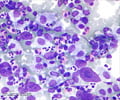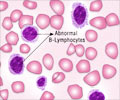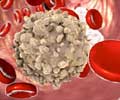AML - Treatment
The aim of treatment for AML is to kill the cancerous cells and enable the bone marrow to work normally again.
Radiation, using high intensity X-rays is rarely employed if the leukemia spreads beyond the bone marrow to other organs. Chemotherapy is the favorite mode of treatment for AML and a combination of drugs is usually employed.
1. Different methods are used during different phases of the disease:
- Induction - Intensive treatment, involving two courses of a combination of chemotherapy drugs, focussed on destroying as many cancer cells as possible is employed in this stage. Standard induction treatment for AML includes two drugs - an anthracycline (such as daunorubicin or idarubicin) in combination with, cytosine arabinoside, a nucleoside analogue. A bone marrow examination is done at the end of this treatment to check for the presence of leukaemia. When there are no signs of leukemia, the patient’s condition is referred to as being in ‘remission’.
- Post-remission - This treatment is given even in the absence of symptoms of leukemia and usually involves two to three courses of chemotherapy. This phase of the treatment aims to destroy any leukaemic cells that may be left and to help to stop the AML from coming back. The purpose of the second phase is to destroy these cells and prevent a relapse. Stem cell transplantation is used instead of consolidated chemotherapy in individuals with poor prognostic features at the time of diagnosis.
When recommending post-remission treatment for a patient several factors are looked into. They include:
The amount of chemotherapy administered to bring about a remission
- The availability of a stem-cell donor who matches the patient’s tissue type
- The possibility of collecting leukemia-free bone marrow stem cells from the patient
- Prognostic factors
- The patient’s age
- Patient’s preference
- Stem Cell Transplantation - Stem cells can be retrieved from the bone marrow, peripheral blood or cord blood. They can be collected from the patient or from the donor. This procedure is usually carried out after chemotherapy as the stem cells in the patients tend to be destroyed after chemotherapy. Stem cell therapy restores the blood cell count. Earlier only young patients were considered for this treatment. Now any individual with good heart, lung and kidney function is certified as a good candidate for this procedure. Stem cell transplantation is very expensive and demands a long hospital stay. It is still at the nascent stage and hence not many insurance companies will be willing to pay for it. Close monitoring is required to manage side- effects.
- Treatment for M3 leukemia - Treatments for patients with M3 leukemia might include transfusions of platelets or other blood products. These patients can develop serious problems related to blood clotting or bleeding and can be managed by giving a blood thinner. The treatment of M3 leukemia differs from the routine AML treatment because a non-chemotherapy drug known as ATRA (related to vitamin A) is combined with other chemotherapy drugs for best results. Another drug, arsenic trioxide, has also been effective in treating these patients.
- Central nervous system treatment - AML may at times affect the brain and spinal cord. This can be prevented by administering chemotherapy directly into the spinal fluid by doing a lumbar puncture. The drug used is cytosine arabinoside and is usually given after each of the first two courses of standard chemotherapy.Sometimes radioactive therapy needs to be given to the brain.
After treatment, it is very important to keep all follow-up appointments.
2. Side effects of treatment
Cancer treatments are likely to cause side- effects as they can also damage some normal cells. Some of the main side effects are listed below -
- Anaemia
- Reduction in the blood cells of the bone marrow
- An increased risk of bruising/ bleeding
- An increased risk of infection
- Loss of apetite
- Weight loss
- Hair Loss
- Nausea and Vomitting
- Heart, kidneys, liver, testes, ovaries, brain, and lungs. Close monitoring may be required
- Problems related to puberty
- Problems related to fertility
- Risk of a second cancer
3. Post–treatment Leukemia
If the leukemia fails to go away or recurs then chemotherapy may not be too helpful. A stem cell transplant can be considered and entering a clinical trial can also be a good idea.
If both these do not work, the focus should be on relieving symptoms:
- Mild chemotherapy will help to slow the growth of cancer.
- In the case of pain, treatment with painkillers is useful.
- Medicines or blood transfusions are required to counter low blood counts and tiredness.
- If depression is a problem, that can be treated as well.
- Nausea and loss of appetite can also be managed by high-calorie food supplements and medicines.
- Antibiotics are used to treat infection.
4. Lifestyle Modifications
The experience of living with cancer is a traumatic one and has a great impact on its victims. Nevertheless it is possible for people to make healthier choices in order to improve the quality of life. Some tips are -
- Increase intake of healthy food. Eat more servings of fruits and vegetables. Avoid fatty or processed food.
- Avoid alcohol
- Exercise regularly. Regular exercise is known even to prevent cancers.
- Rest when required
- Seek the help of support group or seek counseling if necessary












